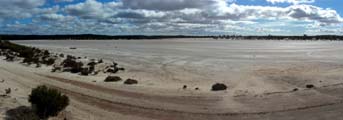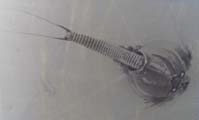The Lake Cowan Salt Lake |
|
Salt lakes can be so salty that salt precipitates in
particles on the surface - or so fresh that tadpoles are
able to survive in them - and this can be in the same lake
(though not at the same time). Big rainfalls produce substantial inflows, giving the
salt lake a depth of up to a metre of basically fresh water. Life on and around salt lakes is not only tough going
for fauna - flora too, has to be highly adapted to survive
these arduous conditions. Samphires have salts in their cells to regulate their
osmotic balances. The various species of Frankenia have developed remarkably
long root systems and appear able to exude salt from their
leaves, which are very small and hard (to reduce moisture
loss). |
|
No liability for timeliness, integrity and correctness of this document is accepted. |
| |

